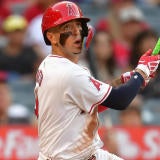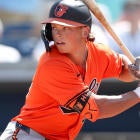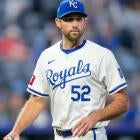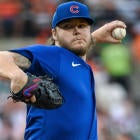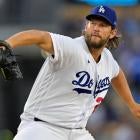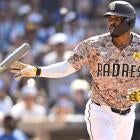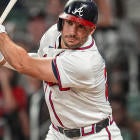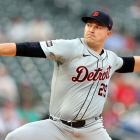
We now know that Wyatt Langford, Jackson Chourio and Jackson Merrill will be in the big leagues on opening day (or even earlier, in Merrill's case).
But not every prospect who's big-league ready made the cut. Some will be needed as reinforcements over the long season ahead. Wouldn't it be great if you could anticipate which ones are next? It would save you some FAB dollars, that's for sure.
And that's the thinking behind this column -- namely, which prospects are most worth stashing ahead of time? It's not strictly a matter of proximity, but also impact. By that, I mean that waiting longer might be worth it for a better prospect.
Naturally, not every league is conducive for stashing prospects. There needs to be ample bench space and few enticing options on the waiver wire. The league needs to be of a certain depth, in other words, and I'd say that only the top two names on this list meet the threshold in shallower leagues.
But even if stashing isn't a thing in your league, it doesn't hurt to know who lies in wait so that you can react quickly if and when he gets the call.
Note that this article was originally published with Colton Cowser and Max Meyer being among the 12, but they surprisingly made the team. They've been replaced by Jackson Holliday and Victor Scott, who, also surprisingly, didn't make the team.
1) Junior Caminero, 3B, Rays
2023 minors: .324 BA (460 AB), 31 HR, .976 OPS, 42 BB, 100 K
2023 majors: .235 BA (34 AB), 1 HR, 1 2B, 2 BB, 8 K
Calling up Caminero last September seemed like a precursor to putting him on the opening day roster. That's been standard operating procedure for top prospects since the latest CBA introduced new incentives to curb service time manipulation. But it became clear from the Rays' offseason maneuvering that they simply wouldn't have room for Caminero at the start of 2024. Isaac Paredes stayed put. So did Brandon Lowe. The DH spot was one possibility, but Jonathan Aranda and Curtis Mead absolutely deserve those chances as well. There's simply a bottleneck of talent in Tampa right now. Injuries to two outfielders, Joshua Lowe and Jonny DeLuca, didn't change the math, but injuries to any infielder could. Or maybe someone like Paredes falters while Caminero continues to hit laser beams at Triple-A, prompting a switch.
2) Jackson Holliday, SS, Orioles
2023 minors: .323 BA (477 AB), 12 HR, 24 SB, .941 OPS, 101 BB, 118 K
GM Mike Elias led everyone on the Orioles beat to believe Jackson Holliday had the inside track on the starting second base job as long as he performed well this spring, and since he was performing well basically from the get-go, most had his ticket punched for the majors already. But guess what? He's in the minors to begin the year, with Elias offering the usual excuses about him being only 20 years old, having little experience in the upper minors and still learning the ropes at second base -- all of which was also true at the start of spring training. Seeing as Ramon Urias is currently occupying a spot on the Orioles infield, the broad assumption is that Holliday will be up within the first six weeks. The biggest concern would be if Coby Mayo, No. 9 on this list, gets there first.
3) Ricky Tiedemann, SP, Blue Jays
2023 minors: 0-5, 3.68 ERA, 1.23 WHIP, 44 IP, 23 BB, 82 K
Injuries to Alek Manoah and Yariel Rodriguez have whittled away the Blue Jays' pitching depth this spring, and particularly in Manoah's case, it's hard to say if they'll be able to count on him at any point. It's left intended starter Bowden Francis as the last viable impediment for the team's top pitching prospect, Tiedemann. The left-hander spent much of last year sidelined by shoulder and biceps issues, but his 16.8 K/9 rate across his 44 innings of work shows the extent of his upside. It does raise the question of how many innings the Blue Jays will allow him to take on this year, but given their lack of pitching depth, they'll probably need Tiedemann before the innings conversations even begin.
4) Kyle Manzardo, 1B, Guardians
2023 minors: .237 BA (351 AB), 17 HR, .802 OPS, 55 BB, 80 K
At the start of spring training, all signs pointed to Manzardo and Josh Naylor alternating between first base and DH to begin the season, but the Guardians apparently had other plans. That's hardly the fault of Manzardo, who hit .381 (8 for 21) with two doubles before the Guardians sent him down. His stat line at Triple-A last year may not impress you, but he made high quality contact and kept his strikeouts in check. He banged at every level before then, too, batting .327 with 22 homers, a 1.043 OPS in 2022. Estevan Florial is expected to get the first crack at DH, but there's a reason he never latched on with the Yankees. He was buried in strikeouts this spring and will probably cede the job to Manzardo before the season is even a quarter done.
5) Paul Skenes, SP, Pirates
2023 minors: 6 2/3 IP, 5 H, 4 ER, 2 BB, 10 K
Every Skenes appearance this spring was appointment viewing, as far as Twitter was concerned, his triple-digit velocity readings being exactly as advertised. You could argue that unless the Pirates are surprise contenders, there isn't much incentive for them to call up Skenes prior to late August, thereby preserving his rookie eligibility for a potential opening day assignment (and possible draft pick rewards) next year. But some on the Pirates beat at least gave lip service to Skenes potentially winning a job this spring before GM Ben Cherington shot it down in early March. Seeing as Skenes was the top pick in the draft last year, all eyes are on him, and if he's as dominant in the upper minors as we expect him to be, the pressure for a midseason call-up may be too great for the Pirates to resist, contenders or not.
6) Jasson Dominguez, OF, Yankees
2023 minors: .265 BA (456 AB), 15 HR, 40 SB, .802 OPS, 83 BB, 133 K
2023 majors: .258 BA (31 AB), 4 HR, 1 2B, 1 SB, 2 BB, 8 K
Dominguez's situation is a little different from these others' because his timetable is outside of anyone's control. He probably won't be up until some point in July because of Tommy John surgery, but he'll almost certainly be up at some point in July, having already proved he belongs with a scintillating first week on the job last September. It's a longer wait than ideal -- and with the possibility of setbacks along the way -- but you should have the luxury of stashing him on the IL in the meantime. You can also feel more confident that he'll have been worth the wait, particularly since he has the makings of a prolific base-stealer in addition to the power. Maybe the Yankees' outfield will still be full by that point, but it's so far away that something is likely to have gone wrong by then.
7) Jordan Lawlar, SS, Diamondbacks
2023 minors: .278 BA (417 AB), 20 HR, 36 SB, .874 OPS, 56 BB, 101 K
2023 majors: 4 for 31 (.129 BA), 1 SB, 2 BB, 11 K
Lawlar's late-season audition last year went so poorly that he never had a serious chance of unseating Geraldo Perdomo for the starting job this spring, but rest assured, Perdomo is no great shakes. He made the All-Star team mostly on the merits of an unsustainable batting average, and naturally, he didn't sustain that batting average, hitting just .214 in the second half. Some of Lawlar's shine is gone, to be sure, but between his disciplined approach and pull-side power, there's still a Marcus Semien-like outcome in there, potentially with even more stolen bases. The Diamondbacks may begin introducing him to other positions just so he's ready to go when an opening presents itself, but shortstop remains the most likely one.
8) Chase DeLauter, OF, Guardians
2023 minors: .355 BA (214 AB), 5 HR, 6 SB, .945 OPS, 23 BB, 30 K
The best prospect no one is talking about came back from a foot injury to hit .355 in what was his pro debut last year, and then he upped the ante by going 13 for 25 (.520) with four homers and more walks (five) than strikeouts (four) this spring. It's understandable that the Guardians would want to send the 22-year-old down with only 57 minor-league games under his belt, but he has the look of a hitting savant who's going to steamroll his way to the majors if he can stay healthy. The team's outfield problems date back years at this point, and they're expected to roll out retreads like Ramon Laureano and Estevan Florial for opening day. It may be closer to July before they concede one of those jobs to DeLauter, but it may not be.
9) Coby Mayo, 3B, Orioles
2023 minors: .290 BA (504 AB), 29 HR, 45 2B, .974 OPS, 93 BB, 148 K
Mayo was thought to be a little further away than Holliday, Cowser and Heston Kjerstad, but he made himself into a fringe candidate for a roster spot with some impressive hitting this spring. And a fringe candidate in spring training is a huge candidate in-season. Speaking of huge, Mayo stands 6-feet-5 and impacts the ball like it, but it was his improved plate discipline that sent his prospect stock into the stratosphere last year. In any other organization, he might be in the top three here, but it's hard to make all the pieces fit for the Orioles. Given how versatile Holliday, Gunnar Henderson and Jordan Westburg are, though, an injury to any one might be enough to clear the way.
10) Victor Scott, OF, Cardinals
2023 minors: .303 BA (548 AB), 9 HR, 94 SB, .794 OPS, 46 BB, 97 K
Scott impressed in camp, showing good hitting instincts for a prospect most renowned for his speed, and seeing as the Cardinals will be without two projected starters in the outfield (Tommy Edman and Lars Nootbaar) for the start of the season, he seemed like he might have positioned himself for one of those two openings. But one was already promised to Alec Burleson, and Dylan Carlson came on late in spring training, securing the other. Scott's stolen base prowess is of particular interest in Rotisserie leagues, and he's almost certainly next in line should something else befall the Cardinals outfield. But because of his limited power ceiling, some might prefer to stash one of the more rounded hitters ahead of him on this list.
11) Pete Crow-Armstrong, OF, Cubs
2022 minors: .283 BA (438 AB), 20 HR, 37 SB, .876 OPS, 46 BB, 129 K
2023 majors: 0 for 19, 2 SB, 3 BB, 7 K
This ranking may seem low for a prospect thought to be in the running for the starting center field job right up until the Cubs elected to bring back Cody Bellinger. Is it just that Crow-Armstrong is blocked now? Not entirely. His defense is enough to force most any center fielder off the position, and Bellinger has some versatility, as you probably know. The bigger issue is that I don't think Crow-Armstrong is nearly the offensive player his minor-league stat line makes him out to be. His exit velocity readings are highly suspect, and between last September and this spring, about the only thing he's done against major-league pitchers is strike out. Still, his premium athleticism may close the skills gap quicker than I'm expecting, and the stolen base contributions should be valuable either way.
12) Brooks Lee, SS, Twins
2023 minors: .275 BA (501 AB), 16 HR, 39 2B, .808 OPS, 56 BB, 91 K
The Twins kept Lee on the big-league side of spring training longer than you'd normally see for a prospect with no realistic opening, which suggests to me that they view him as the next in line, possibly at several positions. His arrival within the first two months of 2024 seems inevitable, then, but the bigger question for Lee than timetable is impact potential. The 23-year-old is a little light on over-the-fence power, and the rest of his tools grade out as closer to a B-minus than an A. If the outcomes range from Brendan Donovan to Alex Bregman, I'd guess he comes closer to the former end of that spectrum, which would still make him worth stashing, but only in deeper leagues. The floor is reasonably high, at least.
What about James Wood?
Few prospects have captured the imagination of Fantasy Baseballers the way Wood has this spring, showing off his power and speed with a more disciplined approach than his 31.5 percent strikeout rate last year might have suggested. No doubt, he's put himself in the discussion for a promotion in 2024 ... but likely not until late August.
The Nationals aren't in any position to contend, and as I've noted with several of the players on this list, the most advantageous time to promote a prospect now is opening day. If he places high enough in awards voting for the first few years of his career, he can score his team extra draft picks, but that only applies if he spends his entire rookie season on the active roster. Wood won't be on the opening day roster this year, and since the Nationals won't need him to contend at any point, they'll likely want to preserve his rookie eligibility for opening day next year. A late-August promotion would accomplish that.
Besides, he'll be 21 for basically the entire season and has yet to play a game above Double-A, where he struggled last year. A little more development time might do him some good, actually.


